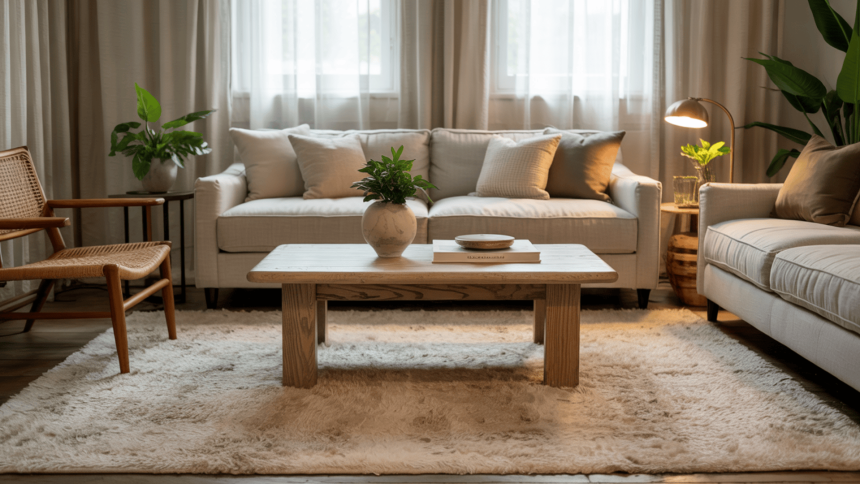Choosing the right rug size can make or break your room’s design. A rug that’s too small will look lost in the space, while one that’s too big might overwhelm the room.
Many homeowners struggle with this decision, especially when shopping online, where it’s hard to visualize how different sizes will look in their actual space.
The 6×9 rug offers a good middle ground for many homes, but it’s not perfect for every situation.
This popular size works well in medium-sized rooms and provides decent coverage without breaking the budget. However, understanding how it compares to other standard sizes is crucial for making the right choice.
This will help you understand how a 6×9 rug compares to other popular sizes. You’ll learn when it works best, what rooms it fits, and how to make the most of this versatile size.
Understanding Standard Rug Sizes
Getting familiar with standard rug dimensions is the first step in making a smart purchase.
Most manufacturers produce rugs in standard sizes that work well in typical room layouts. Knowing these standard options helps you compare prices and find the best fit for your space.
The right rug size affects three key areas:
Layout: A properly sized rug helps define spaces and creates natural walking paths. It shows where furniture should go and makes rooms feel organized.
Comfort: Rugs provide a soft surface under your feet. The right size ensures you step on the rug, not the hard floor, when moving around furniture.
Visual Appeal: A well-sized rug ties the room together. It creates balance and makes spaces feel complete rather than empty or cluttered.
Quick Overview Chart of Common Rug Dimensions
This chart shows how the coverage area increases with each size jump.
Notice that moving from a 5×7 to a 6×9 adds 19 square feet of coverage, while jumping to an 8×10 adds another 26 square feet.
These differences become important when considering both cost and room impact.
| RUG SIZE | BEST FOR | SQUARE FOOTAGE |
|---|---|---|
| 3×5 | Small spaces, accent areas | 15 sq ft |
| 5×7 | Medium rooms, under coffee tables | 35 sq ft |
| 6×9 | Living rooms, bedrooms, and dining areas | 54 sq ft |
| 8×10 | Large living rooms, under dining tables | 80 sq ft |
| 9×12 | Big spaces, open floor plans | 108 sq ft |
Spotlight on the 6×9 Rug

A 6×9 rug measures exactly 6 feet wide by 9 feet long. This gives you 54 square feet of coverage.
To put this in perspective, it’s about the size of a small bedroom or half of a standard parking space.
Basic Dimensions and Coverage
A 6×9 rug measures exactly 6 feet wide by 9 feet long, providing 54 square feet of coverage. This size works well under coffee tables while extending beyond sofa fronts.
Most homeowners find this size manageable for regular maintenance and seasonal room changes, making it practical for everyday use.
Materials and Shapes
Most 6×9 rugs come in rectangular shapes, with some oval options available.
Common materials include wool for durability, cotton for easy cleaning, synthetic blends for stain resistance, and jute for natural texture.
Wool provides longevity but requires more care, while synthetic options resist stains and work well in high-traffic areas.
Average Cost Range
Expect to pay between $150 and $800 for a 6×9 rug, depending on the material and quality. Budget options start around $100, while designer rugs cost $1,000 or more.
Synthetic materials are the most affordable, while hand-woven wool commands premium prices. Most homeowners find good-quality options in the $200-$ 400 range.
6×9 Rug vs Other Common Sizes

Understanding how a 6×9 rug compares to other popular sizes helps you make the best choice for your space and budget.
Each size serves different room types and furniture arrangements, so knowing these differences can save you from costly mistakes.
The following comparisons will help you determine exactly when a 6×9 rug is the best option and when you might need to consider a different size.
6×9 vs 5×7
The 5×7 rug is a popular choice for smaller rooms, but how does it compare to the 6×9? Both sizes work well in homes, but they serve different purposes and room sizes.
| FEATURE | 6X9 RUG | 5X7 RUG |
|---|---|---|
| Coverage | 54 sq ft | 35 sq ft |
| Best for | Medium rooms | Smaller spaces |
| Furniture fit | More pieces can rest on it | Limited furniture placement |
The 6×9 offers 19 more square feet of coverage and works better in medium-sized spaces where a 5×7 might look too small. It fits under more furniture pieces, creating a more unified look, and typically offers better value per square foot.
6×9 vs 8×10
When comparing the 6×9 to the 8×10, you’re looking at a significant jump in size and coverage. The 8×10 is considered a large rug and serves different room needs than the medium-sized 6×9.
| FEATURE | 6X9 RUG | 8X10 RUG |
|---|---|---|
| Coverage | 54 sq ft | 80 sq ft |
| Room size | Small to medium | Medium to large |
| Price | More budget-friendly | Higher investment |
The 6×9 fits smaller rooms more proportionately, while the 8×10 often covers better under beds and dining tables. The 6×9 is easier to move and clean, but the 8×10 can overwhelm smaller spaces.
6×9 vs 9×12
The 9×12 rug represents the largest standard size commonly available, making it quite different from the 6×9 in both coverage and application. This comparison shows the biggest size jump you’ll encounter.
| FEATURE | 6X9 RUG | 9X12 RUG |
|---|---|---|
| Coverage | 54 sq ft | 108 sq ft |
| Best for | Apartments, smaller homes | Large homes, open concepts |
| Budget | More affordable | Significant investment |
The 6×9 is more budget-friendly and apartment-friendly, while the 9×12 dominates large living rooms and open floor plans. The 6×9 is easier to fit through doorways and move, but the 9×12 requires more careful room planning.
6×9 vs Round Rugs (6′ Round)
Comparing rectangular and round rugs involves more than just size – it’s about the different visual impact each shape creates. Round rugs offer a completely different design approach than rectangular ones.
| FEATURE | 6X9 RECTANGULAR | 6′ ROUND |
|---|---|---|
| Coverage | 54 sq ft | 28 sq ft |
| Shape impact | Creates structure | Softens sharp corners |
| Furniture fit | Better under rectangular furniture | Good for conversation areas |
Rectangular rugs work well with most furniture layouts, while round rugs create a softer, more casual look. The 6×9 offers almost twice the coverage of a 6′ round, but round rugs work well in square rooms or under round tables.
Where a 6×9 Rug Works Best
Now that you understand how a 6×9 rug compares to other sizes, it’s time to look at specific rooms and situations where this size shines.
The key to success with any rug is matching it to the right space and furniture layout. A 6×9 rug works well in several different rooms, but the placement and proportion need to be right for the best results.
Living Room
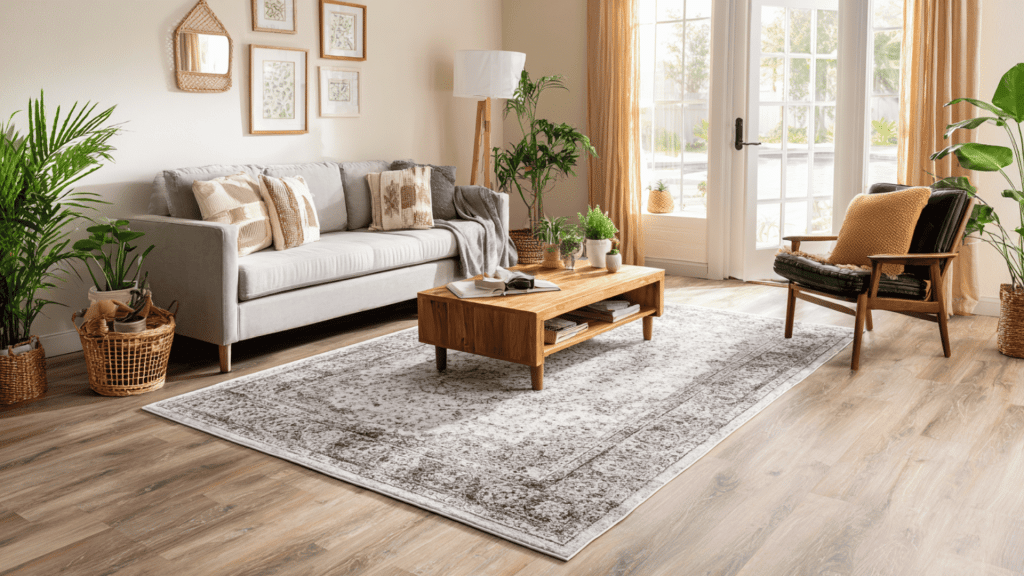
A 6×9 rug works well in living rooms when:
- It fits under your coffee table with room to spare
- The front legs of your sofa can rest on it
- Do you have a medium-sized or open-concept space
- The room measures roughly 12×15 feet or smaller
Pro tip: Leave 18-24 inches of bare floor around the edges for the best look.
Dining Room
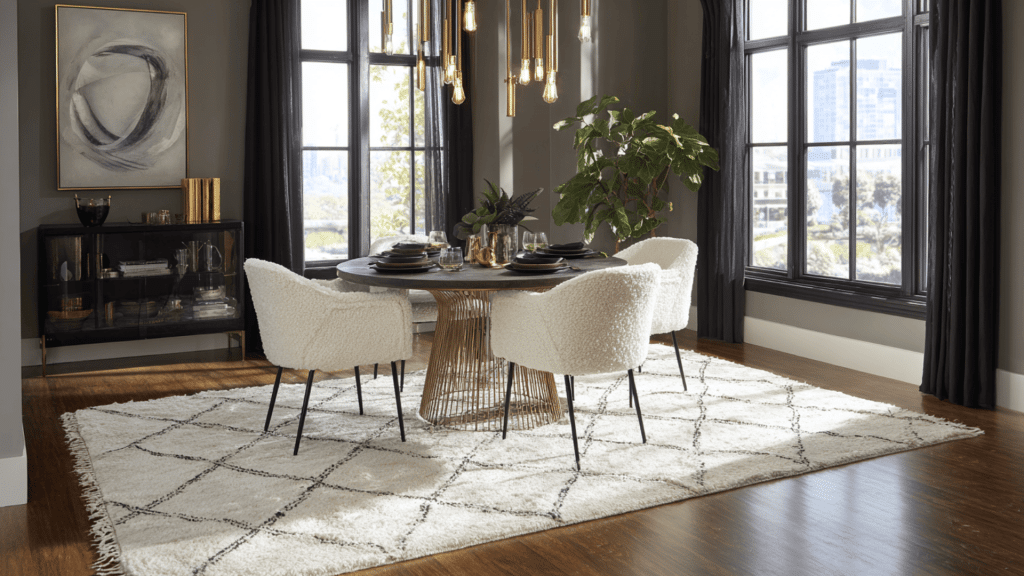
For dining rooms, a 6×9 rug can work with:
- A table that seats 4-6 people
- Smaller dining nooks or breakfast areas
- Round or square tables up to 48 inches across
Important: Measure first. You need at least 24 inches of rug extending beyond the table on all sides so chairs stay on the rug when pulled out.
Bedroom
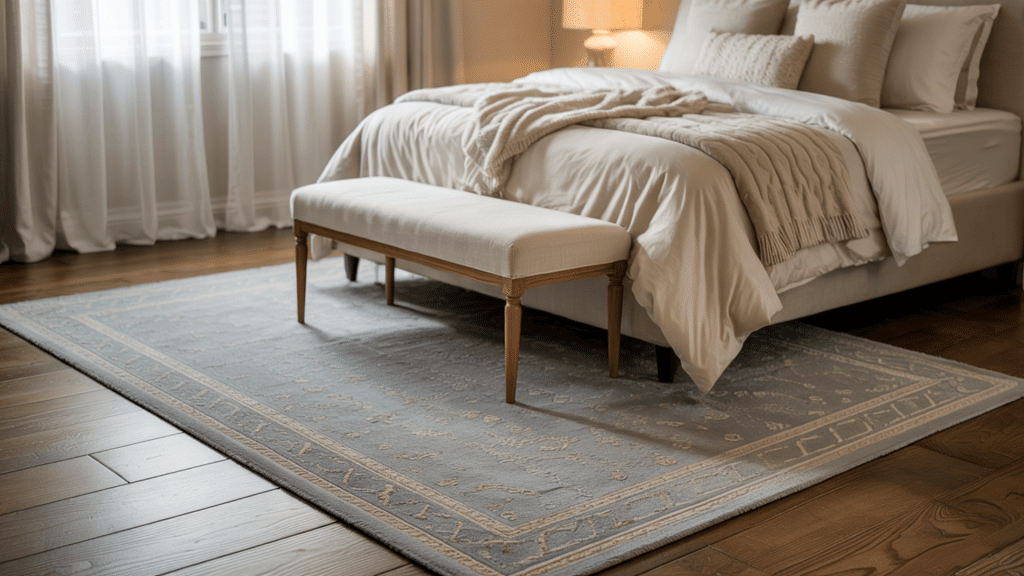
In bedrooms, a 6×9 rug works for:
- Queen beds (with the rug partially under the bed)
- Twin or full beds (with the rug framing the bed)
- Sitting areas within larger bedrooms
- Master bedrooms up to 12×15 feet
Placement tip: Position the rug so 2-3 feet extend beyond the foot of the bed.
Office or Entryway
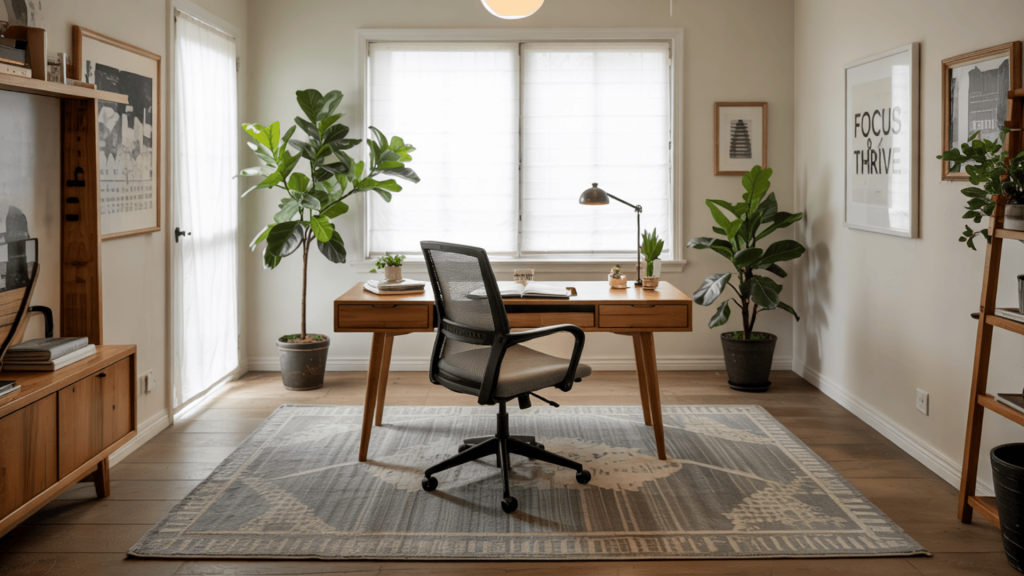
A 6×9 rug can be defined:
- Home office spaces with desk and chair
- Welcoming foyer areas
- Reading nooks or study corners
- Transition spaces between rooms
Pros and Cons of 6×9 Rugs
Before making your final decision, it’s crucial to weigh the advantages and disadvantages of choosing a 6×9 rug.
Like any home decor choice, this size has both strengths and limitations that could affect your satisfaction with the purchase.
| PROS | CONS |
|---|---|
| Versatile for Many Rooms: Works in living rooms, bedrooms, dining areas, and offices. It would be great if you could move it between rooms. | May Feel Small in Large Spaces: You can look lost in big rooms or open floor plans, making the space feel disconnected. |
| Easy to Handle: At 54 square feet, one person can easily move, shake out, or rearrange it. Makes cleaning and room changes simple. | Limited Dining Table Coverage: Does not provide sufficient coverage for larger dining tables that seat 8 or more people. |
| Budget-Friendly: Costs less upfront than larger rugs. Good coverage without the expense of bigger sizes. | Doesn’t Fit Under King Beds: King-size beds need larger rugs to look proportional. A 6×9 might appear too small. |
| Fits Most Furniture: Works well under coffee tables, in front of sofas, and around beds without overwhelming the space. | Less Impact in Grand Spaces: High-ceiling rooms or large open areas may require larger rugs to achieve the desired visual weight. |
After reviewing these pros and cons, you can see that a 6×9 rug works best for medium-sized rooms and flexible living situations.
The advantages often outweigh the disadvantages for most homeowners, especially those in apartments or smaller homes.
However, if you have large rooms or specific furniture requirements, you might need to consider other sizes.
Design Tips for Making the Most of a 6×9 Rug
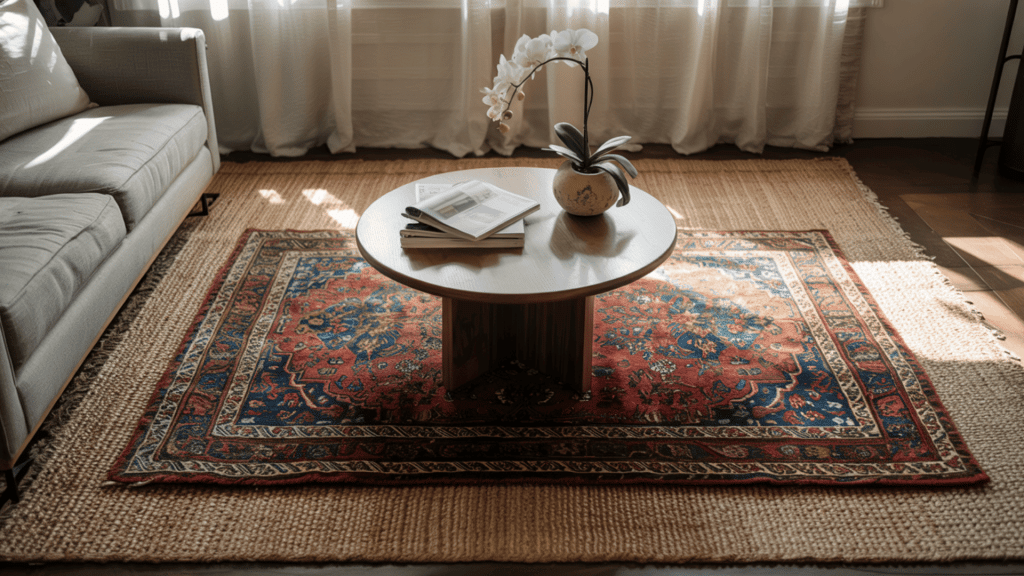
Once you’ve decided that a 6×9 rug is right for your space, the next step is making sure you get the most impact from your purchase.
Proper placement and styling can make your rug look more expensive and help it work better in your room.
These simple design strategies will help you avoid common mistakes and create a polished, professional look.
Layer with a Jute Base Rug
Place a larger, neutral jute rug underneath your 6×9 rug. This creates extra coverage and adds texture. The jute rug should extend 12-18 inches beyond your main rug on all sides.
Center Furniture for Balance
Position your rug so that key furniture pieces relate to it properly:
- Living room: Center the rug with your main seating arrangement so that all furniture legs are consistent with it.
- Bedroom: Align the rug with your bed, either centered underneath or positioned to extend beyond the foot of the bed.
- Dining room: Center the rug under your dining table with enough space for chairs to remain on the rug when pulled out.
Use A Rug Pad
Always put a rug pad under your 6×9 rug. This:
- Prevents slipping: A rug pad keeps your 6×9 rug securely in place and prevents dangerous bunching.
- Adds cushioning: The pad provides extra comfort and softness underfoot for daily use.
- Protects surfaces: It shields both your rug’s backing and your floor from wear and scratches.
- Extends lifespan: A quality pad helps your rug maintain its shape and last significantly longer.
Consider the Room’s Traffic Flow
Place your rug where people naturally walk. This usually means:
- Front of seating: Position the rug where people naturally stand when using chairs, sofas, or other seating.
- Between furniture: Place it in the connecting spaces between key pieces like sofas, coffee tables, and side chairs.
- Natural pathways: Align the rug with the room’s main walking routes to enhance flow and functionality.
Final Thoughts
A 6×9 rug is a great choice for medium-sized rooms, small apartments, or spaces where you want flexibility.
This size is also budget-friendly, easier to clean, and simple to move. If you’re working with limited space or just want a versatile option that can transition between rooms, a 6×9 rug could be ideal.
You can even use online tools to preview how it’ll look. Ultimately, the best rug is the one that makes your room feel complete and balanced.
A 6×9 rug can be that perfect fit for many situations, offering the right combination of coverage, cost, and versatility that most homeowners need.

